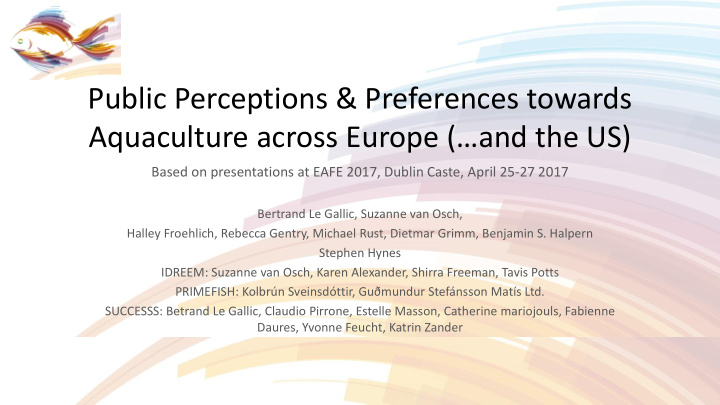



Public Perceptions & Preferences towards Aquaculture across Europe (…and the US) Based on presentations at EAFE 2017, Dublin Caste, April 25-27 2017 Bertrand Le Gallic, Suzanne van Osch, Halley Froehlich, Rebecca Gentry, Michael Rust, Dietmar Grimm, Benjamin S. Halpern Stephen Hynes IDREEM: Suzanne van Osch, Karen Alexander, Shirra Freeman, Tavis Potts PRIMEFISH: Kolbrún Sveinsdóttir, Guðmundur Stefánsson Matís Ltd. SUCCESSS: Betrand Le Gallic, Claudio Pirrone, Estelle Masson, Catherine mariojouls, Fabienne Daures, Yvonne Feucht, Katrin Zander
Who I am? • (Fisheries) Economist a the Unit Research Group AMURE (University of Brest / UBO+ Ifremer) • President of the European Association of Fisheries Economists (EAFE).
The Projects Compilation of research projects (2 first: H2020) • PRIMEFISH Aims to enhance the economic sustainability and competitiveness of European fisheries and aquaculture sectors through studying and analysing the European seafood market • SUCCESS Aims to consolidate the economic sustainability and competitiveness of European fisheries and aquaculture sectors to reap the potential of seafood markets (BGS) by taking great ideas from the lab to the market. • IDREEM Aims to protect the long-term sustainability of European aquaculture by developing and demonstrating Integrated Multi-Trophic Aquaculture (IMTA)
Various Methods to explore public perception about aquaculture products … depending of the objectives (SUCCESS and Primefish how to boost the demand for differentiated products) Discrete choice experiment: • Latent class (IDREEM) • Contingent valuation (SUCCESS) • Probit/bivariate probit (Stephen Hynes) Count method: • Analysis of worldwide aquaculture-related media coverage (Halley Froehlich et al.) • Analysis of policy documents (Halley Froehlich et al.)
Factors Influencing Public Perceptions of Aquaculture (Halley Froehlich) • Approaching aquaculture through social science is relatively new • Perceptions are vital for consumers’ understanding of the industry. • Assessing media coverage of “aquaculture”, “salmon aquaculture” and “offshore aquaculture”
Factors Influencing Public Perceptions of Aquaculture Media coverage of “aquaculture” is Media coverage of “salmon increasing and increasingly positive aquaculture” is mostly negative Year
Factors Influencing Public Perceptions of Aquaculture Media coverage of “offshore aquaculture” is more variable and negative
Perceptions of Aquaculture Consumer Attitudes towards Effects of Aquaculture Economic Benefits Aquaculture Aquaculture Environmental Impact Disease & Economic parasites boost 3,78 5 3,12 Spatial 4 Escapees conflicts 3 2,96 Prevention 3,13 Food safety overfishing 2 3,70 3,48 1 Animal Overfishing welfare 2,87 3,31 Food Job security creation Visual Pollution impact 3,72 3,77 3,27 2,90
Perceptions of Aquaculture Word association Positive core perception Negative peripheral perception
Observations from this compilation • Consumers lack knowledge about aquaculture products and systems (incl. competing species – Seabass ; shrimps; tilapia) • Media might expresses negative concerns instead of clear, targeted issues. • Consumer do value sustainability • Consumers value locally produced seafood
Conclusions • There may well be growth potential for the (European) aquaculture industry • High value niche market for European (local) sustainable seafood • Diversification is critical • Need better communication beyond “farmed vs. wild” • Also in the USA? Merci pour votre Attention
Recommend
More recommend